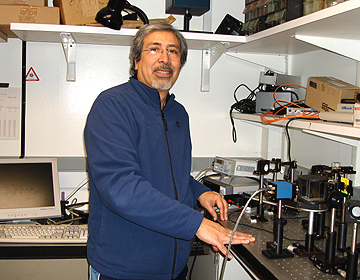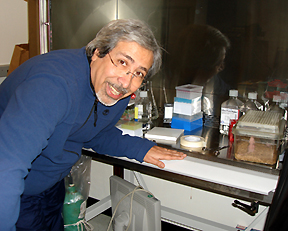
| T H E N I H C A T A L Y S T | J A N U A R Y – F E B R U A R Y 2007 |
|
|
|
Shedding Light on Deep TissueBIOPHOTONICS: THE NEW "AGE OF ENLIGHTENMENT" |
by Fran Pollner |
 |
|
Master
builder:
In addition to constructing equations in his mind, Amir Gandjbakhche builds
countertop prototypes of potential bedside instruments. He notes that
once an experimental technology reaches a point of clinical commercial
potential, his lab moves on to other basic explorations.
|
Sometimes Dr. McCoy’s hand-held device rendered an instant diagnosis as he waved it over a fallen crew member of the Star Ship Enterprise; sometimes it achieved an instant cure.
Such rapid, noninvasive bedside management is not as much a fantasy as one might think.
Amir Gandjbakhche calls it his "dream," but it’s a dream that gets closer to reality, he says, with each advance in optical-imaging research.
"They say the 18th century was the ‘Age of Enlightenment.’ But, really, it’s the 21st century. It’s optical imaging that’s enlightening us, moving us from subjective to quantitative diagnosis," says Gandjbakhche, chief of the Section on Biomedical Stochastic Physics in the Laboratory of Integrative & Medical Biophysics, NICHD.
Gandjbakhche and his team collaborate with other NIH investigators in animal studies and on clinical protocols that involve noninvasive in vivo optical imaging to characterize the physiologic and metabolic environment of diseased tissues.
Modeling Stochastic Processes
The group devises quantitative theories and designs instrumentation for optical spectroscopy and tomographic imaging of tissues.
"We are looking at biological systems with randomness in time and space—that’s a stochastic prcess," says Gandjbakhche.
Using mathematical models to localize lesions and track their changing functional status requires analyzing different optical sources of contrast such as fluorescent labels, absorption, and/or scattering.
Gandjbakhche also builds countertop prototypes of the instruments that might be used at the bedside to characterize the tissues under scrutiny and to monitor response to therapy, instruments that involve neither ionizing radiation nor surgical biopsy, just light.
When light enters biological tissue, it doesn’t go straight in but scatters in many directions, requiring sophisticated methods such as "random-walk theory" to explain the path the light takes through the tissue. This stochastic method, developed at NIH, takes into account the absorption and scattering properties of tissue, which are wavelength dependent, Gandjbakhche explains, noting that a wealth of information can be obtained by spectroscopic methods.
"Light traveling through tissue is a stochastic process. The photons are going everywhere. It’s beautiful," says Gandjbakhche, pointing to a display on his computer screen.
The creation of the vascular network is also stochastic. Fellows Franck Amyot and Alex Small are modeling the stochastic process of tumor-induced angiogenesis in collaboration with NCI’s Kevin Camphausen.
|
The attributes that make optical imaging a choice diagnostic and monitoring modality, says Amir Gandjbakhche, are these:
In short, it’s
"portable, safe, cheap, fast," and provides functional information,
says Gandjbakhche.
|
Some
Ongoing Studies:
Tracking Vasculature Responses In
Kaposi’s Sarcoma Patients
Graduate student Abby Vogel and postdoc Moinuddin Hassan, with NIBIB’s Paul Smith, are monitoring the effect of experimental drugs to counter angiogenesis.
For the past five years, Gandjbakhche’s team has collaborated with Robert Yarchoan, chief of the HIV and AIDS Malignancy Branch, NCI, and Richard Little, senior oncologist, on four clinical protocols involving drug regimens for patients with Kaposi’s sarcoma (KS), a highly vascular tumor.
"We created quantitative methods to assess the vascularity of these tumors using three noninvasive imaging modalities," Gandjbakhche says. "We monitor the results of the drugs being tested and discuss them with the physicians."
"All three imaging modalities," he adds, "take less than five minutes."
Each of these modalities—laser Doppler imaging (LDI), infrared thermal imaging (thermography), and near-infrared multispectral imaging—provides specific, complementary information.
LDI measures blood flux, a combination of red blood cell velocity and concentration; spectral imaging measures changes in blood volume and oxygenated and deoxygenated hemoglobin; and thermography measures temperature as a reflection of blood flow, providing confirmation that changes in the vasculature are related to blood flow.
The spectral-imaging component came about through collaboration with Stavros Demos of the Lawrence Livermore National Laboratory, Livermore, Calif., in designing a portable spectral-imaging system, Gandjbakhche notes.
Overall, the KS studies have thus far demonstrated that the lesions—in addition to being hotter than normal tissue—also register higher blood volume, deoxyhemoglobin, and blood velocity. The cytotoxic/anti-angiogenic combination of liposomal doxorubicin and interleukin-12 is among the agents that have been tested. These imaging techniques can easily be adapted to a variety of skin diseases.
 |
|
Amir
Gandjbakhche leans into his lab’s home for mice in the mouse-imaging
area in Building 9
|
Fluorescence Lifetime Imaging In Mouse Tumor Studies
The applications of fluorescence imaging are limitless, constrained only by the development of fluorophores sensitive to the biological targets of interest.
A fluorophore, Gandjbakhche explains, "is a molecule that has the property to be excited in one wavelength and emits light in a longer wavelength after a delay called lifetime."
"Any condition in which receptors on the cell surface play a role, for instance, is a candidate for fluorescence imaging," says Gandjbakhche. "We need only create antibodies tagged with fluorophores that bind to a specific receptor of interest."
For the past two years, the Gandjbakhche lab has assisted in the mouse tumor studies conducted by Jacek Capala, an investigator in the Radiation Oncology Branch, NCI.
Postdocs Jason Riley and Hassan and staff scientist Victor Chernomordik, along with NICHD colleagues Hacene Boukari and Dan Sackett in the lab of Ralph Nossal, have developed quantitative methods to characterize the molecular and functional status of deeply embedded tumors—breast cancer cells expressing high levels of the HER2 protein.
Gandjbakhche’s team measures fluorophore lifetime because it varies, for instance, with degree of oxygenation or pH value.
"The instrinsic optical properties of the tissues under investigation," he explains, "will yield different functional properties." Fluorophores are chosen for their specific sensitivity to the tissue environment.
Localization of the tumor and quantification of pH was achieved with the use of a fluorophore-Herceptin (a HER2-specific monoclonal antibody) conjugate. The fluorophore was a pH-sensitive near-infrared dye called Alexa Fluor 750. The team intends to continue these studies to investigate an affibody-based molecular probe for imaging HER2 receptors.
"We know exactly what kinds of antibodies to use; we know that tumor cells tend to be hypoxic and have lower pHs than the surrounding tissues."
The IPDC Connection
Gandjbakhche sits on the steering committee of the Imaging Probe Development Center, a new NIH core resource, directed by NHLBI’s Gary Griffiths, for the production of imaging probes, both known but not commercially available and novel (see The NIH Catalyst, January-February 2006).
Gandjbakhche’s proposal to the IPDC that it manufacture a near-infrared dye for optical-imaging research (the review of which he did not participate in) was recently approved. "This dye uses metal chelates to modulate the fluorescence lifetime," Gandjbakhche says, "and it will increase our ability to detect smaller fluorophore concentrations."
Acknowledging that familiarity
with the concepts, language, and calculations of his research is not widespread,
he observes that the "most important part of this work is its multidisciplinary
nature–it takes physicists, engineers, biologists, physicians, chemists.
. . ." ![]()
For an in-depth look at the Gandjbakhche lab and its collaborative work, visit this website.